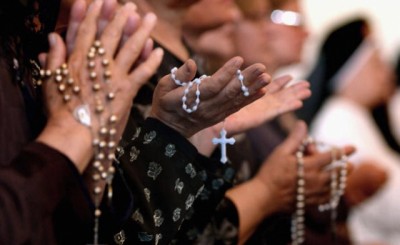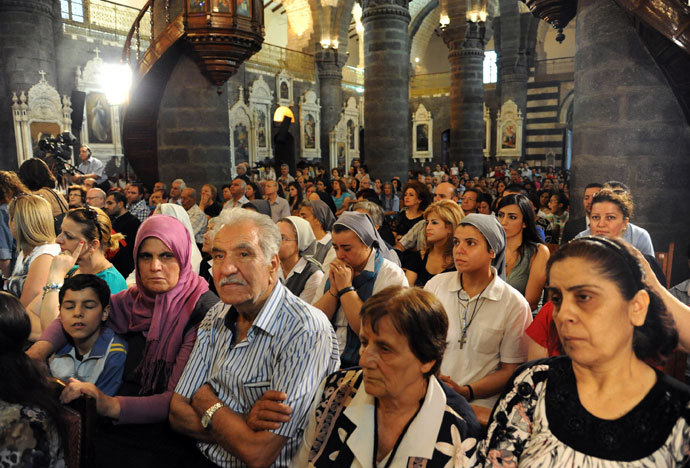How the War on Christians in Iraq and Syria is Paving the Way for a Clash of Civilizations
Wiping Out the Christians of Syria and Iraq to Remap the Mid-East: Prerequisite to a Clash of Civilizations? Part II

The first part of this article discussed the targeting of Christian Syrians and Iraqis. It detailed how their ancient communities, churches, and clerics have all come under fire and persecution by the US-supported insurgents that are ravaging both Syria and Iraq. The second part will explain the rationale behind this and how it is tied to the strategic goals of the US and Israel to redraw the map of the Middle East and North Africa. [1]
There is an attempt to cordon off the Arabs and create distinctive and sharply delineating lines. These lines of delineation are replacing the seamless lines of transition that exist in places like the Middle East, North Africa, and the Balkans. Under this scheme, there can no longer be a melding transition between societies and countries. What is being staged is the creation of an exclusively Muslim region in Syria and the Middle East— excluding the citadel of Israel — that will be in turmoil because of fighting within the Sunni majority and between the Sunni Muslims and the Alawites, Twelver (Jaffari) Shiites, Zaidi Shiites, and Ibadis.
Bkerké’s Maronite Patriarchate Senses the Danger to the Levant’s Christians
Amidst the Arab Spring and the start of the problems in Syria, the Maronite Greek Catholic Syriac Church of Antioch, which is simply called the Maronite Church (after Saint Youhana Maroun, its patron) and the largest of the autonomous Eastern Catholic Churches, appointed a new patriarch on March 15, 2011. The new Maronite patriarch, Mar Beshara Peter (Boutros) Al-Rahi, would shift the underlying politics of the Maronite Patriarchate in Bkerké (and Dimane in the summer) towards a new direction from that of his predecessor Cardinal Mar Nasrallah Boutros Sfeir, who heavily favoured the bigoted warlord Samir Geagea’s Lebanese Forces Party and the Hariri-led March 14 Alliance.
Cardinal Nasrallah was at odds with Damascus and he even refused to visit the Maronite communities inside Syria on church missions himself when he headed the Maronite See, because he said that his visit would signal his approval towards the Syrian regime’s actions inside Lebanon. Cardinal Nasrallah’s supporters would point out, in his support, that he also refused to legitimize Israel by personally visiting it whereas Patriarch Al-Rahi decided to join Pope Francis I and his delegation in 2014 for a meeting with Ecumenical Patriarch Bartholomew I, the figurehead primate of all the Eastern Orthodox Churchs, in Jerusalem to mark the fiftieth anniversary of Pope Paul VI’s meeting with Ecumenical Patriarch Athenagoras I in1964.
Inside Lebanon, Sfeir either had a tense relationship or was at odds with Hezbollah, Michel Aoun’s Free Patriotic Movement, Suleiman Frangieh’s Marada Movement, and the rest of the March 8 Alliance too. Mar Nasrallah’s unyielding positions created divisions among the Maronite Christians and he began to be increasingly opposed by other Maronite bishops, which believed he was endangering the Maronite and Christian positions in Lebanon through his policies. It was even alleged that the Holy See or Vatican intervened and nudged Boutros Sfeir to resign vis-à-vis Cardinal Leonardo Sandri, the Argentine prefect overseeing the congregation of Eastern Catholic Churches for the papacy, and when Cardinal Nasrallah himself went to Rome to visit Pope Benedict XVI and to unveil a statue of Youhana Maroun in Vatican City. These accounts, however, were dismissed by his Maronite supporters as the malicious rumours of his opponents.
Upon his election into the Maronite Patriarchate by the Synod of Maronite Bishops, Cardinal Beshara reversed his predecessor’s personal policies by taking a stand in support of Lebanon’s Hezbollah and its ally Syria. Hezbollah, which had frozen meetings with the Maronite Patriarchate under Boutros Sfier’s leadership, sent a delegation led by senior Hezbollah parliamentarian Mohammed Raad to Bkerké to open a new chapter by renewing dialogue. [2] He also expressed his renewed fears about a purging of Christians in the Levant and the Middle East. In the past he and other Maronite leaders had fears that the Saudi-supported Hariri family could eventually devastate the Christians in Lebanon through its support of fanatical organizations and militias that openly support Al-Qaeda and have anti-Christian tendencies. In 2011, Beshara was warning against the Muslim Brotherhood in Syria. [3] Moreover, Patriarch Al-Rahi, like many other Christian spiritual leaders in Lebanon and Syria, recognized the threat that the insurgence afflicting Syria posed towards all Levantine Christians. Like Hezbollah and the Free Patriotic Movement, Patriarch Al-Rahi also realized that the insurgents would eventually attack Lebanon, if they successfully took over Syria.
Al-Rahi’s support for Hezbollah and Syria became clear when he met French President Nicolas Sarkozy at the Élysée Palace on September 5, 2011. Sarkozy and he had disagreements about regime change in Syria. Patriarch Al-Rahi argued that the Syrians should be left alone and that Syrian polity should be allowed to reform without foreign interference from France and its allies. [4] Nicolas Sarkozy was also told by Patriarch Al-Rahi that the real threat to Lebanon was Israel and that Tel Aviv needed to be neutralized if France was sincere and legitimately wanted Hezbollah’s paramilitary forces to disarm. [5] It was maintained in Lebanon, in the course of the exchange between the two men, that Sarkozy told Beshara that the Christians of Lebanon and Syria could immigrate to the European Union as consolation. This was later denied in a statement released on behalf of the Élysée Palace by the French Embassy in Beirut on September 23, 2011. [6]
Al-Rahi was instantly criticized by the Hariri-led March 14 camp whereas he was thanked by Syria’s Christian and Muslim spiritual leaders, which even visited him as part of an interfaith delegation upon his return to Lebanon. [7] Although they were supposed to visit him after he was elected as the spiritual leader of the Maronites, the Syrian interfaith delegation’s visit had been postponed due to the crisis in Syria. [8] Nonetheless, the Syrian interfaith delegation, accompanied by Syria’s ambassador to Lebanon, took the opportunity to signal its gratefulness by calling on the Maronite Patriarchate in Bkerké. [9] Hezbollah, the Free Patriotic Movement, the Amal Movement, and March 8 applauded Beshara upon his arrival to Beirut from Paris and during his visit to South Lebanon. Prime Minister Najib Al-Mikati and President Michel Suleiman also expressed support for Al-Rahi’s position in France. [10]
A Christian-Muslim Divorce and the Destruction of the «Levantine Cleft»
The New York Times began to assert in 2012 that «Syria’s pluralistic society, which once rose above sectarian identity in a region often characterized by a homicidal assertion of religious belief, is now faced with civil disintegration and ethnic cleansing». [11] The Maronite Patriarchate and the Christian communities of the Levant realized that what was at stake in Syria was much more than the Syrian government. The things that were really at stake were the continuation of the ancient Christian presence and the coexistence of Christians with Muslims, Druze, and Jews, which the Israeli and US governments were trying to demolish with the aim of creating sectarian states that would be line with the so-called «clash of civilizations».
MORE HERE: http://www.globalresearch.ca/wiping-out-the-christians-of-syria-and...
"Destroying the New World Order"
THANK YOU FOR SUPPORTING THE SITE!
Latest Activity
- Top News
- ·
- Everything
What was the Significance of the F-94 C and What role in History?
FLUORIDEGATE: An American Tragedy. a film by Dr. David Kennedy
Rendezvous With The Unknown
Shadows in the Wind
Mossad: we create a pretend world, we are a global production company... the world is our stage
The Alvin II Encounter: Was There A Living Dinosaur Involved?
© 2025 Created by truth.
Powered by
![]()

You need to be a member of 12160 Social Network to add comments!
Join 12160 Social Network